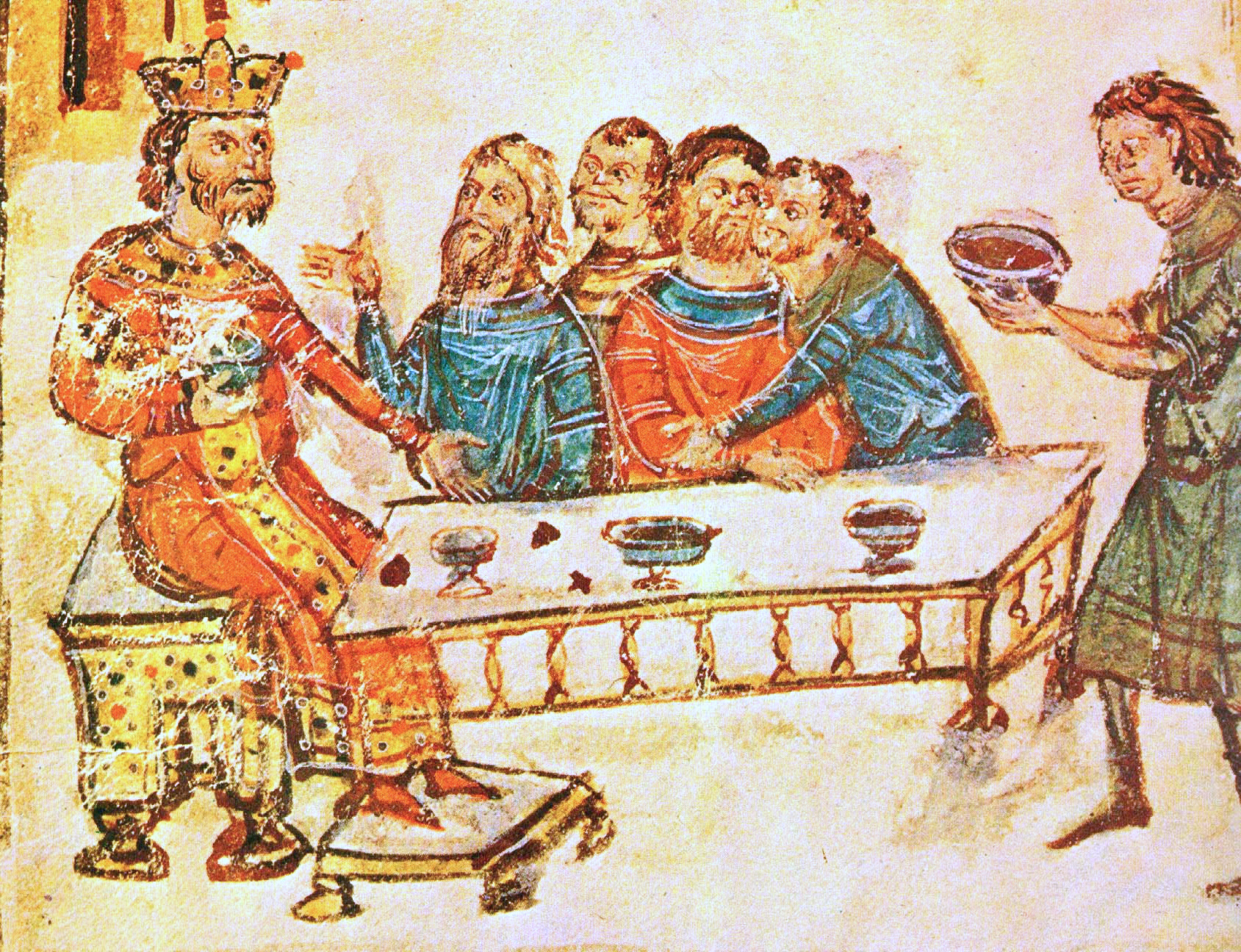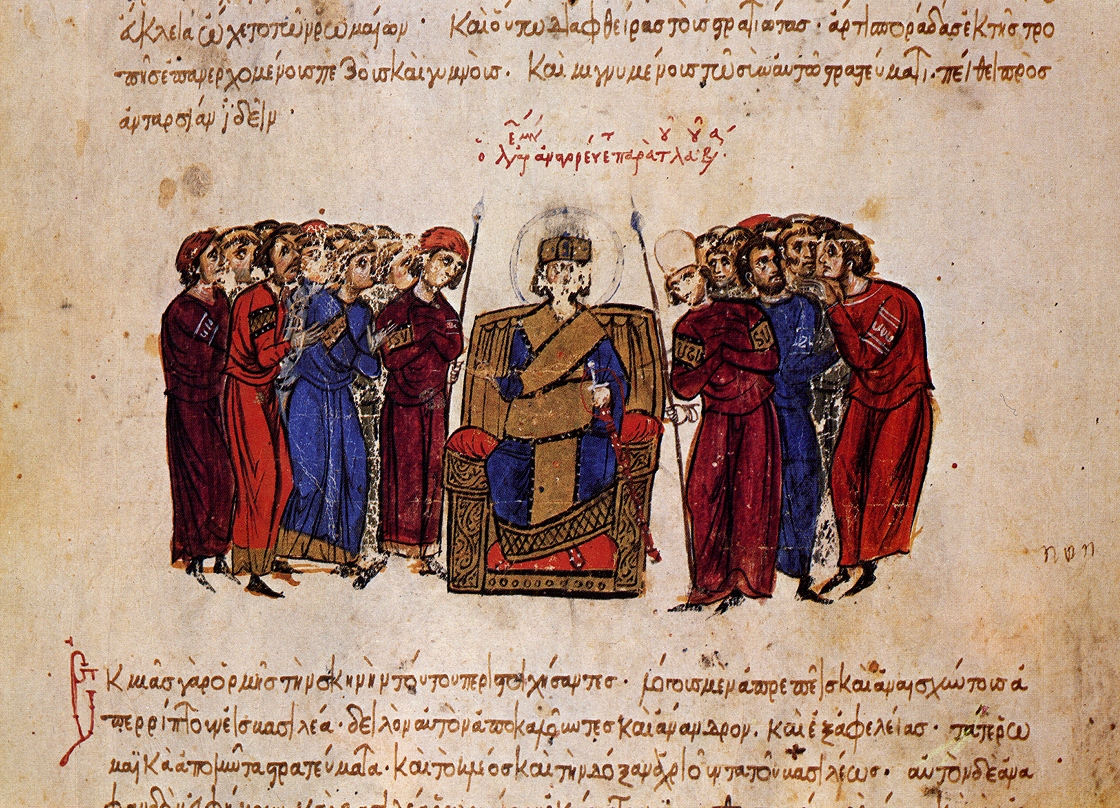|
Versinikia
The Battle of Versinikia ( bg, Битката при Версиникия; el, Μάχη της Βερσινικίας) was fought in 813 between the Byzantine Empire and the Bulgarian Empire, near the city of Adrianople (Edirne). While the Bulgarians, led by Krum, had an army about half the size of the Byzantine Empire, they were victorious, resulting in the dethroning of Byzantine Emperor Michael I Rangabe (811–813) by Leo V the Armenian. The battle was a major success for the Bulgarians and further strengthened the Bulgarian position after their victory over Nicephorus I two years earlier. After the battle they took ''de facto'' control of the whole of Eastern Thrace (until the Byzantine–Bulgarian Treaty of 815) with the exception of a few castles that remained in Byzantine control. For the first time in Bulgarian history, the way to Constantinople was opened. Krum died at the height of the preparation for the final siege of the Byzantine capital on the 13th of April 814. ... [...More Info...] [...Related Items...] OR: [Wikipedia] [Google] [Baidu] |
Krum Of Bulgaria
Krum ( bg, Крум, el, Κροῦμος/Kroumos), often referred to as Krum the Fearsome ( bg, Крум Страшни) was the Khan of Bulgaria from sometime between 796 and 803 until his death in 814. During his reign the Bulgarian territory doubled in size, spreading from the middle Danube to the Dnieper and from Odrin to the Tatra Mountains. His able and energetic rule brought law and order to Bulgaria and developed the rudiments of state organization. Biography Origins Krum was a Bulgar chieftain from Pannonia. His family background and the surroundings of his accession are unknown. It has been speculated that Krum might have been a descendant of the old Bulgar royal house of Kubrat. The name Krum is of Turkic origin and means "governor prince" (from ''kurum'' "rule, leadership, administration"). Establishment of new borders Around 805, Krum defeated the Avar Khaganate to destroy the remainder of the Avars and to restore Bulgar authority in Ongal again, the traditio ... [...More Info...] [...Related Items...] OR: [Wikipedia] [Google] [Baidu] |
First Bulgarian Empire
The First Bulgarian Empire ( cu, блъгарьско цѣсарьствиѥ, blagarysko tsesarystviye; bg, Първо българско царство) was a medieval Bulgar- Slavic and later Bulgarian state that existed in Southeastern Europe between the 7th and 11th centuries AD. It was founded in 680–681 after part of the Bulgars, led by Asparuh, moved south to the northeastern Balkans. There they secured Byzantine recognition of their right to settle south of the Danube by defeatingpossibly with the help of local South Slavic tribesthe Byzantine army led by Constantine IV. During the 9th and 10th century, Bulgaria at the height of its power spread from the Danube Bend to the Black Sea and from the Dnieper River to the Adriatic Sea and became an important power in the region competing with the Byzantine Empire. It became the foremost cultural and spiritual centre of south Slavic Europe throughout most of the Middle Ages. As the state solidified its position in the Balka ... [...More Info...] [...Related Items...] OR: [Wikipedia] [Google] [Baidu] |
Michael I Rangabe
Michael I Rhangabe ( gr, Μιχαὴλ Ῥαγγαβέ; ''c''. 770 – 11 January 844) was Byzantine emperor from 811 to 813. Michael was the son of the patrician Theophylact Rhangabe, the admiral of the Aegean fleet. He married Prokopia, the daughter of the former Emperor Nikephoros I, and received the high court dignity of ''kouropalatēs'' after his father-in-law's accession in 802. Life Michael survived Nikephoros' disastrous campaign against Krum of Bulgaria, and was considered a more appropriate candidate for the throne than his severely injured brother-in-law Staurakios. When Michael's wife Prokopia failed to persuade her brother to name Michael as his successor, a group of senior officials (the ''magistros'' Theoktistos, the Domestic of the Schools Stephen, and Patriarch Nikephoros) forced Staurakios to abdicate in his favor on 2 October 811. Michael I attempted to carry out a policy of reconciliation, abandoning the exacting taxation instituted by Nikephoros I. W ... [...More Info...] [...Related Items...] OR: [Wikipedia] [Google] [Baidu] |
Leo V The Armenian
Leo V the Armenian ( gr, Λέων ὁ ἐξ Ἀρμενίας, ''Leōn ho ex Armenias''; 775 – 25 December 820) was the Byzantine emperor from 813 to 820. A senior general, he forced his predecessor, Michael I Rangabe, to abdicate and assumed the throne. He ended the decade-long war with the Bulgars, and initiated the second period of Byzantine Iconoclasm. He was assassinated by supporters of Michael the Amorian, one of his most trusted generals, who succeeded him on the throne. Life Leo was the son of the patrician Bardas, who was of Armenian descent (according to Theophanes Continuatus, Leo was also of Assyrian that is Syrian descent). Leo served in 803 under the rebel general Bardanes Tourkos, whom he deserted in favor of Emperor Nikephoros I. The Emperor rewarded Leo with two palaces, but later exiled him for marrying the daughter of another rebel, the patrician Arsaber. On the other hand, a contemporary source says that one general Leo of the Armeniakon theme was punish ... [...More Info...] [...Related Items...] OR: [Wikipedia] [Google] [Baidu] |
Thrace
Thrace (; el, Θράκη, Thráki; bg, Тракия, Trakiya; tr, Trakya) or Thrake is a geographical and historical region in Southeast Europe, now split among Bulgaria, Greece, and Turkey, which is bounded by the Balkan Mountains to the north, the Aegean Sea to the south, and the Black Sea to the east. It comprises southeastern Bulgaria (Northern Thrace), northeastern Greece (Western Thrace), and the European part of Turkey ( East Thrace). The region's boundaries are based on that of the Roman Province of Thrace; the lands inhabited by the ancient Thracians extended in the north to modern-day Northern Bulgaria and Romania and to the west into the region of Macedonia. Etymology The word ''Thrace'' was first used by the Greeks when referring to the Thracian tribes, from ancient Greek Thrake (Θρᾴκη), descending from ''Thrāix'' (Θρᾷξ). It referred originally to the Thracians, an ancient people inhabiting Southeast Europe. The name ''Europe'' first referred to ... [...More Info...] [...Related Items...] OR: [Wikipedia] [Google] [Baidu] |
Struma River
The Struma or Strymónas ( bg, Струма ; el, Στρυμόνας ; tr, (Struma) Karasu , 'black water') is a river in Bulgaria and Greece. Its ancient name was Strymṓn (Greek: Στρυμών ). Its drainage area is , of which in Bulgaria, in Greece and the remaining in North Macedonia and Serbia. It takes its source from the Vitosha Mountain in Bulgaria, runs first westward, then southward, forming a number of gorges, enters Greek territory at the Kula village. In Greece it is the main waterway feeding and exiting from Lake Kerkini, a significant centre for migratory wildfowl. The river flows into the Strymonian Gulf in Aegean Sea, near Amphipolis in the Serres regional unit. The river's length is (of which in Bulgaria, making it the country's fifth-longest and one of the longest rivers that run solely in the interior of the Balkans. Parts of the river valley belong to a Bulgarian (Pirin Macedonia) coal-producing area, more significant in the past than nowadays; the ... [...More Info...] [...Related Items...] OR: [Wikipedia] [Google] [Baidu] |
Bulgarian Lands Across The Danube
The Bulgarian lands across the Danube or Transdanubian Bulgaria ( bg, Отвъддунавска България) is a term by which Bulgarian historiography means the territories under the rule and control of the Bulgarian Empire north of the Danube. These territories today cover the territory of Romania and Moldova, eastern Hungary, Vojvodina from Serbia and Budjak in Ukraine. In the Middle Ages the Bulgarian Empire controlled vast areas to the north of the river Danube (with interruptions) from its establishment in 681 to its fragmentation in 1371-1422. These lands were called by contemporary Byzantine historians ''Bulgaria across the Danube''. Original information for the centuries-old Bulgarian rule there is scarce as the archives of the Bulgarian rulers were destroyed and little is mentioned for this area in Byzantine or Hungarian manuscripts. First Bulgarian Empire After the defeat of Great Bulgaria by the Khazars and following Khan Kubrat's death in 668 a large grou ... [...More Info...] [...Related Items...] OR: [Wikipedia] [Google] [Baidu] |
Byzantine Emperor
This is a list of the Byzantine emperors from the foundation of Constantinople in 330 AD, which marks the conventional start of the Eastern Roman Empire, to its fall to the Ottoman Empire in 1453 AD. Only the emperors who were recognized as legitimate rulers and exercised sovereign authority are included, to the exclusion of junior co-emperors (''symbasileis'') who never attained the status of sole or senior ruler, as well as of the various usurpers or rebels who claimed the imperial title. The following list starts with Constantine the Great, the first Christian emperor, who rebuilt the city of Byzantium as an imperial capital, Constantinople, and who was regarded by the later emperors as the model ruler. It was under Constantine that the major characteristics of what is considered the Byzantine state emerged: a Roman polity centered at Constantinople and culturally dominated by the Greek East, with Christianity as the state religion. The Byzantine Empire was the direct le ... [...More Info...] [...Related Items...] OR: [Wikipedia] [Google] [Baidu] |
Siege Machine
A siege engine is a device that is designed to break or circumvent heavy castle doors, thick city walls and other fortifications in siege warfare. Some are immobile, constructed in place to attack enemy fortifications from a distance, while others have wheels to enable advancing up to the enemy fortification. There are many distinct types, such as siege towers that allow foot soldiers to scale walls and attack the defenders, battering rams that damage walls or gates, and large ranged weapons (such as ballistae, catapults/trebuchets and other similar constructions) that attack from a distance by launching projectiles. Some complex siege engines were combinations of these types. Siege engines are fairly large constructions – from the size of a small house to a large building. From antiquity up to the development of gunpowder, they were made largely of wood, using rope or leather to help bind them, possibly with a few pieces of metal at key stress points. They could launch simple ... [...More Info...] [...Related Items...] OR: [Wikipedia] [Google] [Baidu] |
Nessebar
Nesebar (often transcribed as Nessebar and sometimes as Nesebur, bg, Несебър, pronounced ) is an ancient city and one of the major seaside resorts on the Bulgarian Black Sea Coast, located in Burgas Province. It is the administrative centre of the homonymous Nesebar Municipality. Often referred to as the "''Pearl of the Black Sea''", Nesebar is a rich city-museum defined by more than three millennia of ever-changing history. The small city exists in two parts separated by a narrow man-made isthmus with the ancient part of the settlement on the peninsula (previously an island), and the more modern section (i.e. hotels, later development) on the mainland side. The older part bears evidence of occupation by a variety of different civilisations over the course of its existence. It is one of the most prominent tourist destinations and seaports on the Black Sea, in what has become a popular area with several large resorts—the largest, Sunny Beach, is situated immediately to ... [...More Info...] [...Related Items...] OR: [Wikipedia] [Google] [Baidu] |








